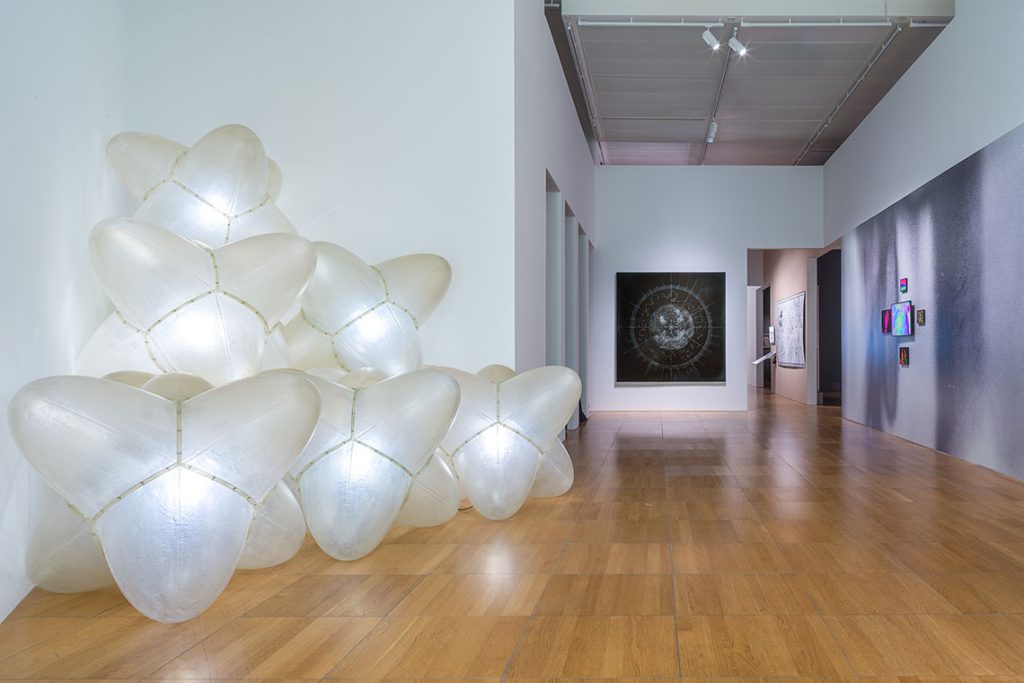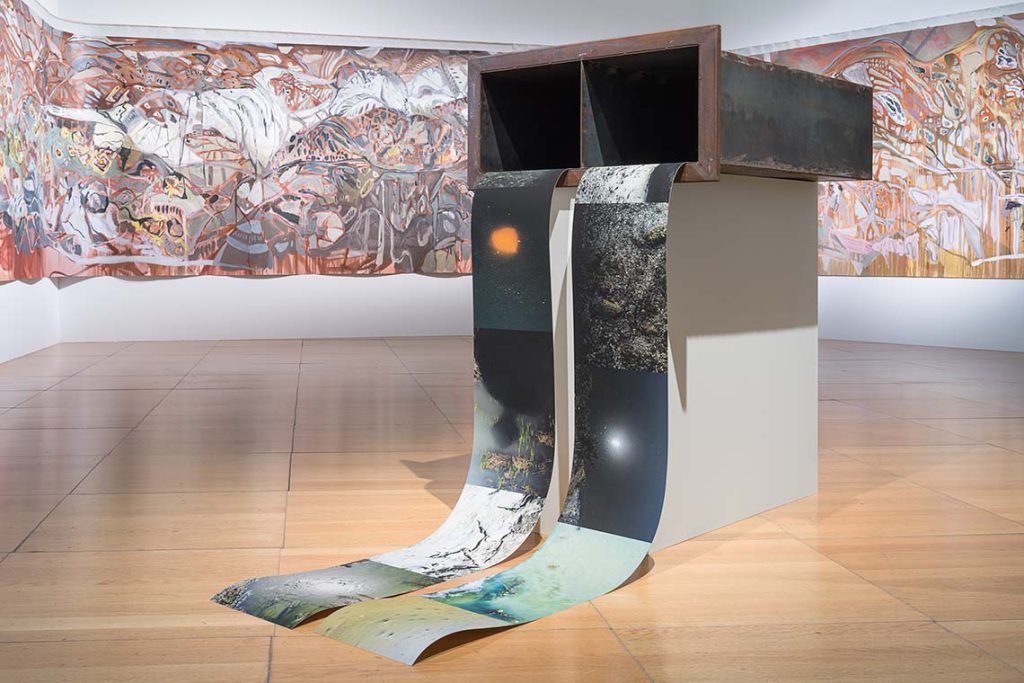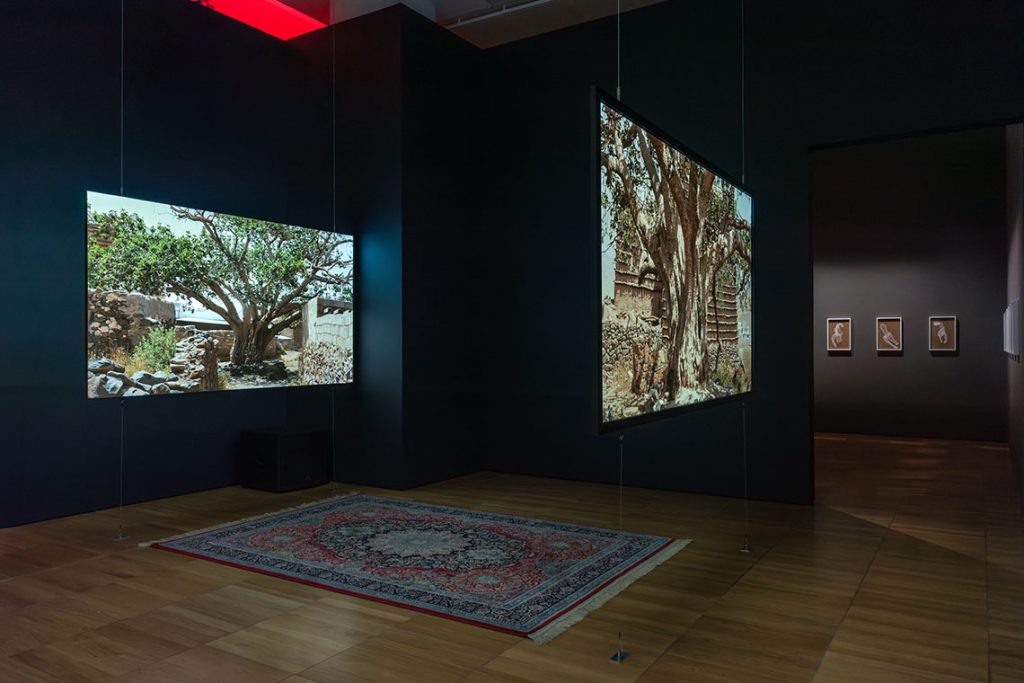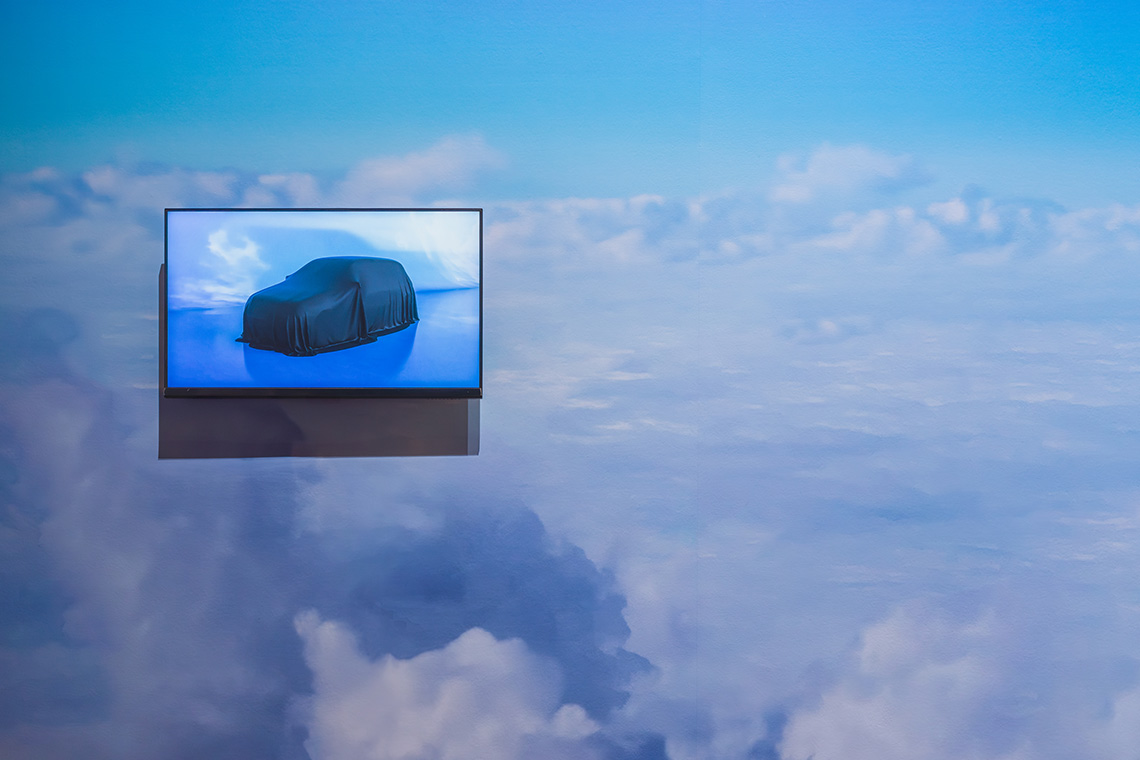Between the Tides: A Gulf Quinquennial at NYU Abu Dhabi Art Gallery presents a fluid and light body of works by a contemporary generation of cross-Gulf artists addressing themes of memory, landscape and shared identity.
Between the Tides: A Gulf Quinquennial at NYU Abu Dhabi Art Gallery is a fluid and light body of works by a contemporary generation of cross-gulf artists that address themes of memory, landscape, and an evolving shared identity assembled out of subjective experiences.
The exhibition has a humid atmosphere and evokes the often ambiguous ecosystem of built and natural surroundings in the region. Through various media and styles, the featured works felt close to the land and its built environments, while opening up a parallel space of imagination.
Sophia Al-Maria’s Breakers (2022) welcomes you into the space. Stacked against a corner is a series of large fibreglass sculptures illuminated from within. The inner glow blinks slowly on and off in swells across the pile. They are modelled after concrete tetrapods used to break up waves along the coastlines. Separated from their functional origins, the ghostly presence of the pods conjures markers of loss and the building blocks of urbanism in the region’s history. In Qatar specifically, the colossal concrete objects aided the increase of new buildings and skyscrapers in the 1970s and 1980s. A moment the artist would have witnessed as a child. The work evokes an otherworldly existence as if you’re seeing it in a memory.

Mohammad AlFaraj’s installation adds to this interplay between the natural and industrial, using thermal imaging to capture scenes from his hometown, Al-Ahsa, in Saudi Arabia. Against a black and white grainy background that covers the wall, The Sun Matches the Heat in my Heart (2019/2024) are framed photographs that seem to reveal everyday mundane details —a hand, a dragonfly—all visibly warm, glowing bright with heat. A video sits among the still images. HEAT (2019/2024) plays scenes of camels grazing alongside schoolchildren walking, the fluttering wings of a dragonfly echoing the beats of a helicopter’s blades. A figure dances with palm branches like wings, and another appears entwined with vines. There is a constant interplay between the varying bodies. AlFaraj’s work poetically explores the quiet rhythm linking all beings.
Nearby, Sarah Brahim’s The Second Sound of Echo (2023), captures further resonances. In the dual-channel video, a man strikes two rocks together, and a woman strikes her collarbone, generating a duet. This man is the artist’s father, who is attempting to make a spark at her request. While recording this, Brahim noticed that his rock-striking followed his breath. She recorded her own percussion, as she followed his cadence and her own heartbeat. The work makes external the internal, in a symbolic gesture that maps out an inherited tempo of life extending over generations.
From when you enter the exhibition, the sound of Faissal El-Malak’s The Lizard of my Dream, (2023) softly accompanies you and draws you closer to itself. Exploring the unconscious and generational trauma, the work reflects on the experience of displacement as the artist sings words from the Palestinian folk song Zareef Al Toul, which translates to “You are leaving for a foreign land, but your own country is more suited for you.”

Around the corner, a vinyl wallpaper offers a view of the calm sky. This is a feature of Bu Yousuf’s world, The Kingdom of Jannah, a surreal space of peace and beauty. This is, My Wife (2019), where the mysterious artist, Bu Yousuf, invites everyone to leave the real world and join him on the clouds. Hanging against the wall, a video shows what seems to be an SUV draped in a cover that pulses lightly by the gentle air. A stack of posters lay out instructions. The words read in Arabic and English, “It must cover the whole body of the car. It should be loose. It should not be see through. It should not resemble the cover of other machines. It should not be decorated. It should not be perfumed. It should not be attractive to the eyes.” You are welcome to take one. Following his directions leads you to The Kingdom.
In Hazem Harb’s Gauze (2023) series, fragile, layered forms resembling weightless bodies against handmade cardboard in the colour of the artist’s skin. These pieces seem to convey a healing process; the translucent woven fabric, traditionally used to protect wounds, is believed to originate from his hometown of Gaza, Palestine. Harb arranges the works in a sequence that you watch rise and fall as you move across the room. Together, they compose a meditation on resilience and identity that feels both abstract and personal.

Ayman Zedani’s installation, The Ancient Ones (2023), opens up another sacred space in the exhibition and carries on the exploration of resilience. In the centre of a three-channel video a carpet is laid, two sides are hanging screen projections and the third side is projected onto a wall. The protagonists of this work are what the artist calls the region’s “sentinels”—trees that have withstood centuries of change. Zedani’s lens follows these trees, some over 1,400 years old, capturing their symbolic resilience. The work invites you into an intimate connection with the sparkling sun rays pouring through the leaves and the shade of the big thick branches stretching out towards the sky. The project was sparked by the wildfires that ravaged Jabal Ghulamah in 2020, which burned for nine days before rain provided relief. Surviving the disaster was an ancient tree, its endurance a testament to safeguarding these living witnesses to history against humanity’s threatening impacts on our climate.
The tactile ecological narrative continues with Aziz Motawa’s Outfall (2022/2024), where natural elements and industrial remnants blend in contrast. A murky gush of photo paper spews into the gallery through a metal vent. The images capture marshy landscapes and kinship with the mudskippers. You can feel your feet sinking into the mud, enveloped in the soft grip. You lay down, close to the earth’s surface which is alive with wild organisms. You feel a sticky and cold feeling on your wet skin as you lose yourself in the brine. The work is a simple gesture that leaves a big impact, merging the personal, ecological and industrial. Between the Tides offers a nuanced look at the Gulf, immersing you in the region’s shifting tides and leaving you with impressions that linger like the salty air of its coastline.
Between the Tides: A Gulf Quinquennial runs until 20 April 2025



